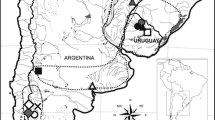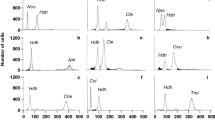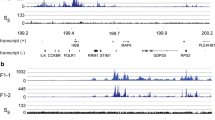Abstract
Cell membrane-dependent chromatin condensation was studied by flow cytometry in erythrocytes of 36 species from six classes of vertebrates. A positive relationship was found between the degree of condensation and genome size. The distribution of variances among taxonomic levels is similar for both parameters. However, chromatin condensation varied relatively more at the lower taxonomic levels, which suggests that the degree of DNA packaging might serve for fine-tuning the ‘skeletal’ and/or ‘buffering’ function of noncoding DNA (although the range of this fine-tuning is smaller than the range of genome size changes). For two closely related amphibian species differing in genome size, change in chromatin condensation under the action of elevated extracellular salinity was investigated. Condensation was steadier and its reaction to changes in solvent composition was more inertial in the species with a larger genome, which is in agreement with the buffering function postulated for redundant DNA. The uppermost genome size in vertebrates (and in living beings in general) was updated using flow cytometry and was found to be about 80 pg (78,400 Mb). The widespread opinion that the largest genome occurs in unicellular organisms is rejected as being based on artifacts.




Similar content being viewed by others
References
Allison DC, Ridolpho PF, Rasch EM, Rasch RW, Johnson TS (1981) Increased accuracy of absorption cytophotometric DNA values by control of stain intensity. J Histochem Cytochem 29:1219–1228
Anatskaya OV, Vinogradov AE (2004) Heart and liver as developmental bottlenecks of mammal design: evidence from cell polyploidization. Biol J Linn Soc 83:175–186
Bachmann K (1970) Feulgen slope determinations of urodele nuclear DNA amounts. Histochemistry 22:289–293
Beaton MJ, Cavalier-Smith T (1999) Eukaryotic non-coding DNA is functional: evidence from the differential scaling of cryptomonad genomes. Proc R Soc Lond B 266:2053–2059
Bennett MD (1971) The duration of meiosis. Proc R Soc Lond B 178:277–299
Bennett MD (1987) Variation in genomic form in plants and its ecological implications. New Phytol 106(Suppl):177–200
Bennett MD (1998) Plant genome values: how much do we know? Proc Natl Acad Sci U S A 95:2011–2016
Bennett MD, Leitch IJ (2003) Plant DNA C-values database (release 2.0). Available at http://www.rbgkew.org.uk/cval/homepage.html
Bird AP (1995) Gene number, noise reduction and biological complexity. Trends Genet 11:94–100
Brodsky VY, Uryvaeva IV (1985) Genome multiplication in growth and development. Cambridge University Press, Cambridge
Byers TJ (1986) Molecular biology of DNA in Acanthamoeba, Amoeba, Entamoeba, and Naegleria. Int Rev Cytol 99:311–341
Castillo-Davis CI, Mekhedov SL, Hartl DL, Koonin EV, Kondrashov FA (2002) Selection for short introns in highly expressed genes. Nat Genet 31:415–418
Cavalier-Smith T (1978) Nuclear volume control by nucleoskeletal DNA, selection for cell volume and cell growth rate, and the solution of the DNA C-value paradox. J Cell Sci 34:247–278
Cavalier-Smith T (1985) Cell volume and the evolution of eukaryote genome size. In: Cavalier-Smith T (ed) The evolution of genome size. Wiley, Chichester, pp 105–184
Cavalier-Smith T, Beaton MJ (1999) The skeletal function of non-genic nuclear DNA: new evidence from ancient cell chimaeras. Genetica 106:3–13
Comeron JM (2001) What controls the length of noncoding DNA? Curr Opin Genet Dev 11:652–659
Eisenberg E, Levanon EY (2003) Human housekeeping genes are compact. Trends Genet 19:362–365
Felsenstein J (1985) Phylogenies and the comparative method. Am Nat 125:1–15
Gregory TR (2001) Coincidence, coevolution, or causation? DNA content, cell size, and the C-value enigma. Biol Rev Camb Philos Soc 76:65–101
Gregory TR (2002a) A bird’s-eye view of the C-value enigma: genome size, cell size, and metabolic rate in the class Aves. Evolution 56:121–130
Gregory TR (2002b) Genome size and developmental complexity. Genetica 115:131–146
Grime JP, Mowforth MA (1982) Variation in genome size—an ecological interpretation. Nature 299:151–153
Grime JP, Shacklock JML, Band SR (1985) Nuclear DNA contents, shoot phenology and species co-existence in a limestone grassland community. New Phytol 100:435–445
Hartl DL (2000) Molecular melodies in high and low C. Nat Rev Genet 1:145–149
Hoffman J, Katz U (1997) Salt and water balance in the toad Bufo viridis during recovery from two different osmotically stressful conditions. Comp Biochem Physiol A 117:147–154
Hurst LD (1995) Evolutionary genetics. The silence of the genes. Curr Biol 5:459–461
James J (1972) DNA constancy and chromatin structure in some cell nuclei of Amphiuma. Histochem J 4:181–192
Kalney VS, Kudryavtsev BN, Kudryavtseva MV (1974) Relation between radiosensitivity and DNA content in nuclei of various Amoeba proteus strains. Acta Protozool 12:111–116
Kato H, Harada M, Tsuchiya K, Moriwaki K (1980) Absence of correlation between DNA repair in ultraviolet irradiated mammalian cells and life span of the donor species. Jpn J Genet 55:99–108
Kim C, Rubin CM, Schmid CW (2001) Genome-wide chromatin remodeling modulates the Alu heat shock response. Gene 276:127–133
Kinsman EA, Lewis C, Davies MS, Young JE, Francis D, Vilhar B, Ougham HJ (1997) Elevated CO2 stimulates cells to divide in grass meristems: a differential effect in two natural populations of Dactylis glomerata. Plant Cell Environ 20:1309–1316
Kozlowski J, Konarzewski M, Gawelczyk AT (2003) Cell size as a link between noncoding DNA and metabolic rate scaling. Proc Natl Acad Sci U S A 100:14080–14085
Li TH, Kim C, Rubin CM, Schmid CW (2000) K562 cells implicate increased chromatin accessibility in Alu transcriptional activation. Nucleic Acids Res 28:3031–3039
Licht LE, Lowcock LA (1991) Genome size and metabolic rate in salamanders. Comp Biochem Physiol B 100:83–92
Loborg H, Rundquist I (1997) DNA binding fluorochromes as probes for histone H1–chromatin interactions in situ. Cytometry 28:212–219
Lynch M, Conery JS (2003) The origins of genome complexity. Science 302:1401–1404
Macgillivray CW, Grime JP (1995) Genome size predicts frost resistance in British herbaceous plants: implications for rates of vegetation response to global warming. Funct Ecol 9:320–325
Martins EP (2001) COMPARE, v. 4.4. Computer programs for the statistical analysis of comparative data. Available at: http://compare.bio.indiana.edu/. Department of Biology, Indiana University, Bloomington, Ind
McAdams HH, Arkin A (1999) It’s a noisy business! Genetic regulation at the nanomolar scale. Trends Genet 15:65–69
Mommsen TP (2001) Paradigms of growth in fish. Comp Biochem Physiol B Biochem Mol Biol 129:207–219
Moore PD (1985) Nuclear DNA content as a guide to plant growth rate. Nature 318:412–413
Ohno S (1999) Gene duplication and the uniqueness of vertebrate genomes circa 1970–1999. Semin Cell Dev Biol 10:517–522
Olmo E (1983) Nucleotype and cell size in vertebrates: a review. Basic Appl Histochem 27:227–254
Olmo E (2003) Reptiles: a group of transition in the evolution of genome size and of the nucleotypic effect. Cytogenet Genome Res 101:166–171
Pedersen RA (1971) DNA content, ribosomal gene multiplicity, and cell size in fish. J Exp Zool 177:65–79
Petrov DA (2001) Evolution of genome size: new approaches to an old problem. Trends Genet 17:23–28
Petrov DA (2002) Mutational equilibrium model of genome size evolution. Theor Popul Biol 61:531–544
Rock J, Eldridge M, Champion A, Johnston P, Joss J (1996) Karyotype and nuclear DNA content of the Australian lungfish, Neoceratodus forsteri (Ceratodidae: Dipnoi). Cytogenet Cell Genet 73:187–189
Shpun S, Hoffman J, Katz U (1992) Anuran amphibia which are not acclimable to high salt, tolerate high plasma urea. Comp Biochem Physiol A 103:473–477
Spear BB, Prescott DM (1980) Nuclear DNA in normal and refed Amoeba proteus. Exp Cell Res 130:387–392
Sternberg R (2002) On the roles of repetitive DNA elements in the context of a unified genomic–epigenetic system. Ann NY Acad Sci 981: 154–188
Szarski H (1983) Cell size and the concept of wasteful and frugal evolutionary strategies. J Theor Biol 105:201–209
Tautvydas KJ (1971) Mass isolated ameba nuclei. I. Isolation procedure and determination of macromolecular composition and RNA polymerase activity. Exp Cell Res 68:299–308
Thastrom A, Lowary PT, Widom J (2004) Measurement of histone–DNA interaction free energy in nucleosomes. Methods 33:33–44
Trivers R, Burt A, Palestis BG (2004) B chromosomes and genome size in flowering plants. Genome 47:1–8
Urrutia AO, Hurst LD (2003) The signature of selection mediated by expression on human genes. Genome Res 13:2260–2264
Van’t Hof J, Sparrow AH (1963) A relationship between DNA content, nuclear volume and minimum mitotic cycle time. Proc Natl Acad Sci U S A 49:897–902
Vervoort A (1980) Tetraploidy in Protopterus (Dipnoi). Experientia 36:294–296
Vinogradov AE (1995a) Nucleotypic effect in homeotherms: body mass-corrected basal metabolic rate of mammals is related to genome size. Evolution 49:1249–1259
Vinogradov AE (1995b) Cell membrane-dependent chromatin condensation. Cytometry 19:183–188
Vinogradov AE (1996) Post-fixation method of cell viability assessment with flow cytometry. Acta Histochem Cytochem 29(Suppl):527–528
Vinogradov AE (1997) Nucleotypic effect in homeotherms: body mass-independent resting metabolic rate of passerine birds is related to genome size. Evolution 51:220–225
Vinogradov AE (1998a) Buffering: a possible passive-homeostasis role for redundant DNA. J Theor Biol 193:197–199
Vinogradov AE (1998b) Genome size and GC-percent in vertebrates as determined by flow cytometry: the triangular relationship. Cytometry 31:100–109
Vinogradov AE (2000) Larger genomes for molluskan land pioneers. Genome 43:211–212
Vinogradov AE (2003) Selfish DNA is maladaptive: evidence from the plant Red List. Trends Genet 19:609–614
Vinogradov AE (2004a) Evolution of genome size: multi-level selection, mutation bias or dynamical chaos? Curr Opin Genet Dev 14:620–626
Vinogradov AE (2004b) Genome size and extinction risk in vertebrates. Proc R Soc Lond B 271:1701–1705
Vinogradov AE (2004c) Compactness of human housekeeping genes: selection for economy or genomic design? Trends Genet 20:248–253
Vinogradov AE, Anatskaya OV (2004) Phenological resonance and quantum life-history. J Theor Biol 228:417–420
Wakamiya I, Newton RJ, Johnston JS, Price HJ (1993) Genome size and environmental factors in the genus Pinus. Am J Bot 80:1235–1241
Wakamiya I, Price HJ, Messina MG, Newton RJ (1996) Pine genome size diversity and water relations. Physiol Plantarum 96:13–20
Waltari E, Edwards SV (2002) Evolutionary dynamics of intron size, genome size, and physiological correlates in archosaurs. Am Nat 160:539–552
Zuckerkandl E (2002) Why so many noncoding nucleotides? The eukaryote genome as an epigenetic machine. Genetica 115:105–129
Acknowledgements
This work was supported by the Russian Foundation for Basic Research (RFBR) and by the Programme of the Presidium of the Russian Academy of Sciences ‘Molecular and Cellular Biology’ (MCB RAS).
Author information
Authors and Affiliations
Corresponding author
Additional information
Communicated by E.A. Nigg
Rights and permissions
About this article
Cite this article
Vinogradov, A.E. Genome size and chromatin condensation in vertebrates. Chromosoma 113, 362–369 (2005). https://doi.org/10.1007/s00412-004-0323-3
Received:
Revised:
Accepted:
Published:
Issue Date:
DOI: https://doi.org/10.1007/s00412-004-0323-3




